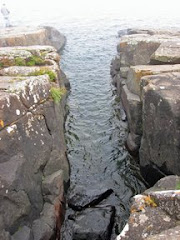Monday, February 25, 2013
Business as usual for Minnesota mining
Reader's view:
http://www.duluthnewstribune.com/event/article/id/259710/
Business as usual for Minnesota mining
The latest report from the UMD Labovitz School of Business and Economics (as reported on by the News Tribune in the Feb. 7 story, “UMD report underscores value of iron ore mining, potential for copper”), is business as usual in the world of mining in Minnesota.
Once again we get a promotional brochure for the mining industry masquerading as an economic report.
To make judgments about proposed industrial developments, the civilized world usually agrees that a cost-benefit analysis is required. But all we get from the University of Minnesota Duluth is a list of benefits. There was no apparent discussion of costs, of elevated sulfates in Lake Vermilion or of heavy metals leaching from the Dunka pit. I noticed no hint of the dead zone for wild rice in the St. Louis River, no analysis of the blighted communities along the length of the Mesabi Range and no acknowledgement of the poverty rate in Virginia, the heart of the Mesabi Range.
“Regulatory capture” refers to the industry domination of agencies meant to regulate them. “Deep capture” occurs when the industry dominates the media, academia and popular culture. It seems to me the state of Minnesota has been captured by the mining industry.
The editorial pages of the Duluth News Tribune and the publications of the Labovitz School of Business and Economics should be adequate proof of Minnesota’s subjugation to mining interests.
Robert Tammen
Soudan
http://www.duluthnewstribune.com/event/article/id/259710/
Business as usual for Minnesota mining
The latest report from the UMD Labovitz School of Business and Economics (as reported on by the News Tribune in the Feb. 7 story, “UMD report underscores value of iron ore mining, potential for copper”), is business as usual in the world of mining in Minnesota.
Once again we get a promotional brochure for the mining industry masquerading as an economic report.
To make judgments about proposed industrial developments, the civilized world usually agrees that a cost-benefit analysis is required. But all we get from the University of Minnesota Duluth is a list of benefits. There was no apparent discussion of costs, of elevated sulfates in Lake Vermilion or of heavy metals leaching from the Dunka pit. I noticed no hint of the dead zone for wild rice in the St. Louis River, no analysis of the blighted communities along the length of the Mesabi Range and no acknowledgement of the poverty rate in Virginia, the heart of the Mesabi Range.
“Regulatory capture” refers to the industry domination of agencies meant to regulate them. “Deep capture” occurs when the industry dominates the media, academia and popular culture. It seems to me the state of Minnesota has been captured by the mining industry.
The editorial pages of the Duluth News Tribune and the publications of the Labovitz School of Business and Economics should be adequate proof of Minnesota’s subjugation to mining interests.
Robert Tammen
Soudan











































































































